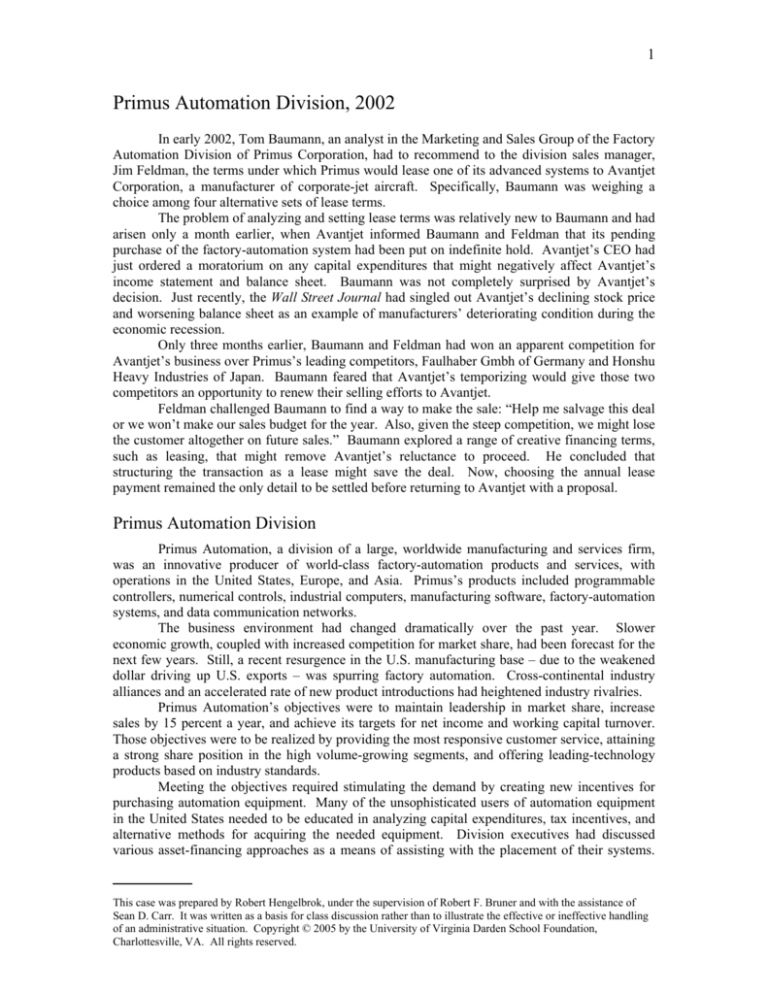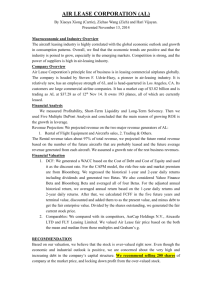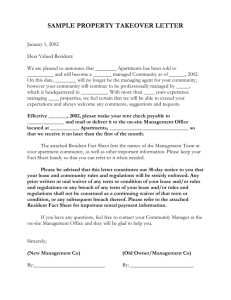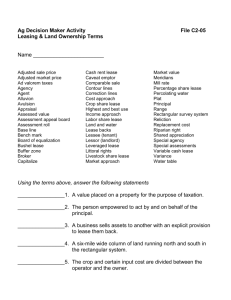
1
Primus Automation Division, 2002
In early 2002, Tom Baumann, an analyst in the Marketing and Sales Group of the Factory
Automation Division of Primus Corporation, had to recommend to the division sales manager,
Jim Feldman, the terms under which Primus would lease one of its advanced systems to Avantjet
Corporation, a manufacturer of corporate-jet aircraft. Specifically, Baumann was weighing a
choice among four alternative sets of lease terms.
The problem of analyzing and setting lease terms was relatively new to Baumann and had
arisen only a month earlier, when Avantjet informed Baumann and Feldman that its pending
purchase of the factory-automation system had been put on indefinite hold. Avantjet’s CEO had
just ordered a moratorium on any capital expenditures that might negatively affect Avantjet’s
income statement and balance sheet. Baumann was not completely surprised by Avantjet’s
decision. Just recently, the Wall Street Journal had singled out Avantjet’s declining stock price
and worsening balance sheet as an example of manufacturers’ deteriorating condition during the
economic recession.
Only three months earlier, Baumann and Feldman had won an apparent competition for
Avantjet’s business over Primus’s leading competitors, Faulhaber Gmbh of Germany and Honshu
Heavy Industries of Japan. Baumann feared that Avantjet’s temporizing would give those two
competitors an opportunity to renew their selling efforts to Avantjet.
Feldman challenged Baumann to find a way to make the sale: “Help me salvage this deal
or we won’t make our sales budget for the year. Also, given the steep competition, we might lose
the customer altogether on future sales.” Baumann explored a range of creative financing terms,
such as leasing, that might remove Avantjet’s reluctance to proceed. He concluded that
structuring the transaction as a lease might save the deal. Now, choosing the annual lease
payment remained the only detail to be settled before returning to Avantjet with a proposal.
Primus Automation Division
Primus Automation, a division of a large, worldwide manufacturing and services firm,
was an innovative producer of world-class factory-automation products and services, with
operations in the United States, Europe, and Asia. Primus’s products included programmable
controllers, numerical controls, industrial computers, manufacturing software, factory-automation
systems, and data communication networks.
The business environment had changed dramatically over the past year. Slower
economic growth, coupled with increased competition for market share, had been forecast for the
next few years. Still, a recent resurgence in the U.S. manufacturing base – due to the weakened
dollar driving up U.S. exports – was spurring factory automation. Cross-continental industry
alliances and an accelerated rate of new product introductions had heightened industry rivalries.
Primus Automation’s objectives were to maintain leadership in market share, increase
sales by 15 percent a year, and achieve its targets for net income and working capital turnover.
Those objectives were to be realized by providing the most responsive customer service, attaining
a strong share position in the high volume-growing segments, and offering leading-technology
products based on industry standards.
Meeting the objectives required stimulating the demand by creating new incentives for
purchasing automation equipment. Many of the unsophisticated users of automation equipment
in the United States needed to be educated in analyzing capital expenditures, tax incentives, and
alternative methods for acquiring the needed equipment. Division executives had discussed
various asset-financing approaches as a means of assisting with the placement of their systems.
This case was prepared by Robert Hengelbrok, under the supervision of Robert F. Bruner and with the assistance of
Sean D. Carr. It was written as a basis for class discussion rather than to illustrate the effective or ineffective handling
of an administrative situation. Copyright © 2005 by the University of Virginia Darden School Foundation,
Charlottesville, VA. All rights reserved.
2
Asset-Financing Approaches
Baumann discussed with Primus’s division executives the variety of ways a firm might
acquire the use of a Primus Automated Factory System. First, the customer could purchase a
system with cash or with borrowed funds, either unsecured or collateralized by the equipment.
Second, the firm could acquire the equipment through a conditional sale in which the title would
pass to the firm upon the receipt of the final payment. Finally, the customer could lease the
equipment in one of two ways: (1) via a cancelable operating lease, which could carry a term that
was less than the economic life of the property; or (2) via a noncancelable financial capital lease
that would span the entire economic life of the property.
Capital versus Operating Leases
Baumann reviewed his notes on the rules defining the two types of leases. To be
classified as a capital lease under the guidelines of Financial Accounting Standards Board
(FASB) Statement No. 13,1 the lease had to meet one or more of the following four criteria:
a. Ownership of the asset transferred by the end of the lease term.
b. The lease contained a bargain-purchase option, whereby the lessee had to pay the fair
market value for the property at the end of the lease.
c. The lease term was equal to 75 percent or more of the economic life of the property.
d. The present value of the lease payments over the lease term was equal to or greater than
90 percent of the fair market value of the leased property at the beginning of the lease.
If the lease qualified as a capital lease, then the lessee would be required to depreciate the
equipment by showing it as an asset and a liability on its balance sheet. The lessee could not
deduct the lease payment from its income taxes. At the end of the lease, the lessee retained
ownership and bore the risk of early changes in the asset’s value.
If the lease met none of the foregoing criteria, it would be classified as an operating lease.
As an operating lease, the lease payments would be treated as an ordinary expense, deductible
from taxable income. The leased property would not appear on the lessee’s balance sheet and,
after the lease term, would revert to the lessor.
Primus Automation had never before offered leasing and was unfamiliar with the actual
workings of leasing arrangements. Fortunately, the Equipment Finance Division of Primus’s
parent company had extensive leasing expertise and assisted Baumann in his research. As he dug
out some of the information that the division had sent him, Baumann realized that this was the
first application of his efforts and he wanted to make sure he understood all the nuances involved
with leasing.
Avantjet
Baumann had heard that Avantjet’s vice president of operations was determined to get an
automation system to cut costs and accelerate his company’s production line. A large backlog of
orders for both new jets and the retrofitted older models had put new demands on production.
Without such a system, it would be very difficult to meet promised deliveries. In addition,
Baumann knew that Avantjet’s capital-budgeting process included all major expenditures – new
construction and capital leases – but excluded operating leases.
The risk of obsolescence and the ability to upgrade equipment weighed heavily in
Avantjet’s decision. Overall, the most important factor was cash flow, because Avantjet wanted
1
Statement of Financial Accounting Standards No. 13: Accounting for Leases, Financial Accounting
Standards Board (November 1976), 7-9.
2
3
to avoid any additional unplanned expenditures in 2002. Avantjet was very capital intensive and
was only marginally profitable because it was so highly leveraged. (Exhibits 1 and 2 show
Avantjet’s income statement and balance sheet)
With that in mind, Baumann wondered how he was going to find a way to resolve all the
issues. He knew that many companies had turned to leasing to address some of those concerns.
Although many of the large firms in the airframe industry were not as cash strapped as the smalland medium-sized shops, it was worthwhile to find out what classes of customers would benefit
financially from leasing. Baumann surmised that tax rates and cost-of-capital disparities between
the lessor and lessee might be critical drivers in any lease arrangement.
Primus’s Competitors
Several months earlier, when Avantjet was reviewing system proposals from Primus,
Honshu and Faulhaber, Baumann and Feldman learned from Avantjet that all three systems were
roughly equivalent but differed in pricing. Table 1 summarizes the pricing options then
available:
Table 1 | Summary of the available pricing options (in US$)
System Manufacturer
Faulhaber Gmbh
Honshu Heavy Industries
Primus Automation Division
Purchase Price of
System if Avantjet
Were to Buy
$805,000
$787,000
$745,000
Quoted Annual Lease Expense and
Guaranteed Residual Value2 for
5-Year Operating Lease
$160,000; 27% residual value
$158,000; 25% residual value
Not previously quoted
Baumann had learned from industry newsletters that foreign manufacturers sometimes
exploited their allegedly lower costs of capital as a competitive weapon in designing financing
terms for their customers. Baumann wondered whether this was apparent in the lease terms
proposed by Faulhaber and Honshu, and planned to estimate the effective lease costs under their
respective proposals.
Primus’s Lease Proposal
The particular deal that Feldman had called Baumann about was a proposal for a
$745,000 factory-automation system. This equipment would enable Avantjet to operate a group
of workstations from a central control site while gaining valuable feedback and planning
capabilities. Realizing that he had to find out more about Avantjet’s motives for delaying the
project, Baumann quizzed Feldman about Avantjet’s performance and requirements. Feldman
told Baumann that Avantjet’s last CEO had been replaced by a senior executive from outside the
firm who was more concerned about the bottom line and the balance sheet than he was about
making capital expenditures that had long paybacks.
With that in mind, Baumann began to assess this particular deal. The price of the total
package was $745,000. Baumann assumed that Avantjet’s primary alternative to leasing was to
borrow the purchase price of the equipment on a non-amortizing five-year loan. The Equipment
Finance Division also quoted Baumann two alternatives for a five-year operating lease with equal
annual payments (due at the beginning of each year) that varied depending on Avantjet’s actual
tax rate and cost of debt. At the end of the lease term, renewal was subject to negotiation
between the two parties. Factory-automation equipment was classified as technological
2
Residual value was the estimated fair value of a leased asset at the end of the lease term. Because future
values were difficult to predict, residual values were often highly subjective. Equipment leases typically
stipulated a guaranteed residual value.
3
4
equipment with a five-year life. Five-year MACRS3 depreciation rates, based on the full value of
the property, were as follows in Table 2:
Table 2 Five-Year MACRS
Income Tax Depreciation Rate Schedule
Year
Percentage
1
20.00
2
32.00
3
19.20
4
11.52
5
11.52
In order to structure it as an operating lease, the Equipment Finance Division required an
20.2729 percent residual guarantee from Baumann’s division. Baumann did not know how
sensitive to the residual assumption the results would be. Because his division was trying to
move into leasing to bolster sales, he figured that it might be willing to assume some of the risk of
the equipment’s value declining substantially in five years. Primus Automation might also have
to assist the Equipment Finance Division in remarketing the equipment to another user, if a new
lease were not signed when the original lease expired. (Exhibit 3 lists the various pricing and
leasing terms)
EXHIBIT 1 | Avantjet’s Statement of Income ($000’s)
2001
$576,327
9,985
586,312
2000
$575,477
6,976
582,453
1999
$432,522
9,677
442,199
425,076
43,624
13,773
84,062
423,443
36,215
12,873
87,259
325,016
35,632
9,064
27,002
566,535
559,790
396,714
Income before taxes
Taxes
19,777
6,724
22,662
7,705
45,485
15,465
Net income
13,053
14,957
30,020
Sales
Other income
Gross income
Cost of good sold
Selling, general & admin.
Research & development
Interest
Total expenses
Source: Company records.
3
MACRS stood for modified accelerated cost recovery system. It was a method of accelerated
depreciation allowed under the U.S. Tax Code. Under MACRS, depreciation deductions were determined
without regard to the asset’s residual value. The terminal loss or gain will be directly incorporated into firm
profit/loss. To compare with the Canadian tax code, this is identical to the assumption that the asset pool is
terminated at the end of the lease term.
4
5
EXHIBIT 2 Avantject's Balance Sheet ($000)
2001
2000
$19,918
37,791
310,180
13,928
381,817
$27,263
37,307
323,101
13,362
401,033
2,245
30,654
26,932
1,683
1,668
63,182
12,634
50,548
640,369
$1,072,734
2,245
30,229
21,244
1,520
885
56,123
8,267
47,856
648,339
$1,097,228
$592
42,355
4,750
$563
38,760
5,760
39,627
146,964
234,288
43,855
160,946
249,888
646,633
42,661
689,294
671,255
41,498
712,723
3,385
74,081
72,017
-331
149,152
$1,072,734
3,027
69,770
62,156
-336
134,617
$1,097,228
Assets
Current assets:
Cash and temporary investments
Accounts receivable
Inventories
Prepaid expenses
Total current assets
Property, plant, and equipment:
Land
Buildings
Machinery and equipment
Furniture and fixtures
Construction in progress
Less accumulated depreciation
Net property, plant, and equipment
Other assets
Total assets
Liabilities and stockholders' equity
Current liabilities:
Long-term debt
Accounts payable
Notes payable
Accrued compensation, interest,
and other liabilites
Deposits and progress payments
Total currect liabilities
Long-term nots payable to banks
Deferred income taxes
Common Stockholders' equity:
Common stock
Capital in excess of par value
Retained earnings
Less common stock in treasury
Total stockholders' equity
Total Liabilities and stockeholders' equity
Source: Company records
5
6
EXHIBIT 3 Terms under Hypothetical Leasing and Borrow-and-Buy
Strategies
Loan ("Borrow-and-Buy")
5-year term loan
Payment in arrears
Equipment cost
Cash Down Payment
Loan amount
Lease
5-year net lease
Leasing option #1
Leasing option #2
Both Methods
Guaranteed residual value:
(required by Primus Equipment Finance Division)
Investment tax credit
Depreciation
$745,000
$0
$745,000
Annual payments
(in advance)
$150,003
$152,350
20.2729%
0%
Five-year MACRS
Issues to be addressed:
Tom Bauman needs to prepare a report to his manager, Jim Feldman. In this report, he
will clarify the following issues:
1. Compare the advantages and disadvantages of operating lease for Avantjet relative to
other alternatives including (1) borrow-and-buy, and (2) capital lease.
2. Prepare a projected balance sheet and income statement for Avantjet in year 2002 after
the first lease payment under leasing option #2, assuming that everything else remain the
same as in year 2001. Repeat the same exercise supposing that the lease is structured as a
capital lease by including a bargain purchase option, which requires Avantjet to purchase
the equipment at $60,000 by the end of the fifth year. Assume no taxation and Avantject
had about the same borrowing cost as Primus (about 9.5 percent). Show your calculation
and journal entries in appendix. Persuade Jim Feldman that given Avantjet’s situation,
operating lease is a preferred choice.
3. Assume no taxation, calculate the minimum lease payment acceptable to Primus.
Assume Avantject had about the same borrowing cost as Primus (about 9.5 percent).
4. Estimate the effective tax rate of Avanjet from the past three years' income statements.
Assume Avantjet had about the same borrowing cost as Primus (about 9.5 percent). At
the current point, Primus has a tax rate of 40%. This tax rate is estimated to last in the
next couple of years.
4.1 In exhibit 3, there are two leasing options. Evaluate the economic feasibility of
these two options based on the tax rates and interest rate provided above.
6
7
4.2 Compare Primus’ leasing option #1 with the competing offers from Faulhaber
Gmbh and Honshu Heavy Industries (See table 1). Comment on the competitiveness of
Primus.
4.3 What is the minimum lease payment acceptable to Primus? Compare the minimum
lease payment in this context with the minimum lease payment you derived from the
above (issue 3). Comment on the taxation effect.
4.4 What’s the maximum lease payment acceptable to Avantjet?
5. Small- and medium-size firms probably paid higher interest rates than Primus and
could save money if Primus financed the equipment and passed on some of the financing
savings to them. Based on Avantjet’s income statement and balance sheet, Bauman is
able to estimate the interest rate for Avantjet. He noticed that the interest rate for Avantjet
is indeed higher.
5.1 What is the minimum lease payment acceptable to Primus now?
5.2 What is the maximum lease payment acceptable to Avantjet now?
5.3 Since 2005 regulators have been concerned that the all-or-nothing capitalization
method of the current standards on leases results in off-balance sheet financing. They are
specifically critical of its rules- vs. principles-based approach, the 75% economic life and
90% fair value tests, and the complexity of the statement. The regulatory bodies feel that
material operating leases must be capitalized to show a truer picture of the lessee's
financial position. One suggested approach to accounting for leases is the asset and
liability approach which suggests that the lessee capitalize all material leases at the value
of the lessee's rights and obligations under the lease. How would this new approach, if
instituted, impact Bauman’s recommendation to Avantjet?
5.4 With a variety of options and scenarios to propose to Avantjet, Baumann believed
that Primus had a good chance of resurrecting the deal and meeting its sales goals for
2002. Persuade Jim that he is right.
6. Combining your knowledge in both accounting and finance, what factors do you think
determine whether or not a firm should engage in leasing? Apply this knowledge to
Primus and Avantjet.
7
8
Instruction: Prepare a report, according to the expectations of the case.
INTEGRATIVE CASE REPORT EXPECTATIONS
The Goals
The integrative case is a project of the instructors of Managerial Finance II (AFM 371/372) and
Intermediate Financial Accounting II (AFM 391). The case is a multi-subject case that has the
following objectives:
to encourage integration of materials from these two subject areas,
to encourage the development of case analysis skills,
to use a variety of information sources to solve an accounting problem, and
to reinforce the development of report writing skills.
The total mark of the case project includes two components: the report and the peer evaluation
based on the individual contribution for the report. The total mark will count for 10% towards the
final grades in AFM 371/372 and AFM 391 respectively, or equivalently, a combined 20% for
two courses. Out of the combined 20%, the report will receive 17% for which each group member
receives same mark, and the peer evaluation will receive the rest 3%.
Logistics
Do not contact any representative of the company. Only use publicly available information.
Due Date
The final report is due at 5:00 p.m., Thursday, November 20, 2008. It can be placed in the gray
drop box outside HH290. A 10% penalty will be levied for each day that the assignment is late,
no exceptions or excuses.
Report Expectations
Formal Expectations
1. The case is designed to integrate the topics from within, and across, the two courses. Your
analysis and report should demonstrate an integration of these concepts. Your report should
identify key issues and analyze these to arrive at a reasonable, well thought out solution.
State clearly both quantitative and qualitative recommendations that you make.
2. Your report must meet the standards of professional report writing, as taught in your English
class. Your writing must be clear, concise and free of grammatical or spelling errors.
3. Your report should be appropriate to the audience specified in the requirements of the case.
8
9
4. You can work in a group not exceeding four members. You cannot discuss the case with
anyone other than your own group members. You are bound by the ethical standards of the
university, as summarized in the course outlines of the accounting courses.
Technical Requirements
1. The main text of the report should be typed on 8” x 11” paper, double-spaced with 1”
margins on all four borders, typed with a Times New Roman font size no smaller than 11
point (i.e. this size). The main text of your report (not including the cover page, executive
summary, the table of contents, and the reference page) will be no more than eight pages.
2. Appendices, spreadsheets, exhibits and tables should not exceed an additional eight pages.
3. The report should also include a title page and a one page executive summary. The summary
should summarize the key points in your analysis and your recommendations. It should not
describe what will be found in the report, but rather summarize the contents of the report.
4. Submit only one copy of the report.
Evaluation Criteria
1. As in prior accounting and finance courses, content is particularly important. In this setting,
thoroughness and thoughtfulness of the analysis are the key components of content. Do not
simply perform a superficial analysis of the issues; rather attempt to understand the issues at a
greater depth. Review course material to determine the relevant knowledge and analyses and
try to think beyond the obvious facts and figures presented in the case materials.
2. Integration of materials will also be rewarded.
3. Recommendations should be clear and supported by the analysis performed.
Style is also important. Take on the role given and write to the audience specified.
Other Guidance and “Tips”
1. Determine the primary thrust of your report before you begin to write. Compose the report
such that everything contributes to this primary thrust. Plan your structure to achieve your
goals.
2. This is a business report. Be very careful to write to a relatively sophisticated business
reader.
3. Pay close attention to how material is presented in graphs and tables. Each such exhibit
should be completely self-explanatory with clear and accurate labels. Looking only at the
exhibit alone, can its message be clearly understood?
4. If you wish to cite outside materials (other than those provided directly to you), be selective
in how you cite these – this is a business report, not an academic essay. The case is designed
such that significant additional outside materials are not necessary to complete the analysis.
9







